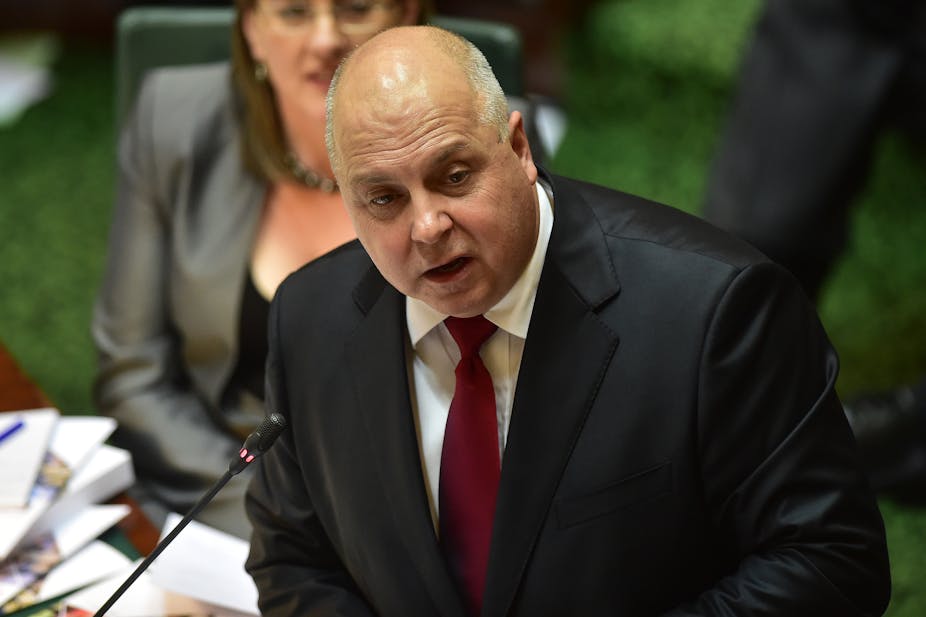Victorian Treasurer, Tim Pallas, delivered the Andrews’ Labor government’s first budget yesterday, and promptly received a warm ovation. His budget was aimed squarely at Labor’s heartland, shifting spending from privately constructed roads to publicly delivered services in health, education and community services, while simultaneously keeping net debt low, and the operating account firmly in the black.
In so doing, Pallas drew attention to a marked shift that has occurred in the Australian federation, which has seen a two speed economy transform into a two budget one instead. Whereas the former was based on the resources boom, the budget divide is based on something different, with the two non-resource driven economies of Victoria and NSW emerging with the strongest budgets in the land.
Both are now running substantial budget operating surpluses, both have managed to crank up infrastructure spending to record levels, and both have managed to keep service delivery growing, albeit under what might end up being quite different models.
NSW has opted to continue its privatisation push, preferring Public Private Partnerships, long-term leases and outsourcing of community services over traditional procurement and public sector delivery, irrespective of the cost. In fact, NSW premier Mike Baird reacted poorly during the recent NSW election to suggestions that the privatisation model might be good for a lot of reasons, but the budget bottom line was not amongst them.
Victoria has chosen a different path. Pallas’ budget has placed service delivery over infrastructure as a priority, and has budgeted for a whopping 7.1% increase in spending on public service wages and salaries. Some of this will fund pay rises, but the bulk will end up in new staffing, following years of austerity under the Coalition.
Both states have managed to put in place budgets that are strong enough to withstand the funding cuts coming out of Joe Hockey’s disastrous first budget, which managed to cost shift a lot of the federal austerity measures to the states by way of cuts to specific purpose grants for health, community services and education.
In contrast stand the other states whose budgets remain stretched, but also under varying conditions of repair. South Australia long ago abandoned its commitment to a AAA budget, and has pragmatically accepted running small operating deficits in the interests of the overall health of the economy. In 2015/16 the operating accounts are set to return to surplus.
Remarkably, despite these apparently unfashionable settings, the Jay Weatherill-led Labor government was returned last year, albeit with a two party vote that fell short of anything like a majority. Weatherill has turned the Federal cuts to his political advantage, pointing successfully to Joe Hockey as a reason why budget consolidation in his state is proving so hard.
Tasmania is also doing it tough, and its newly elected Liberal government has found that turning operating deficits into surpluses is a mighty hard equation, particularly with an economy that’s struggling to grow in real per capita terms. It would be best to continue to use the budget to try to balance the economy, rather than force a budget correction that could trigger a costly recession.
The resource states of Queensland and Western Australia are also struggling, with the latter facing a perfect storm when not so long ago it was facing a perfect summer. Queensland’s financial woes are largely one of self-perception, reflecting budget settings far harsher than other jurisdictions and a strange determination by the now-ousted Campbell Newman government to talk down its public finances.
Whereas all the other states measure their financial bottom lines by pointing to their operating balance and net indebtedness, Queensland has opted for the unnecessarily tougher goal of keeping the budget in the black and reducing gross liabilities.
And in contrast to the other States prepared to use both tax increases and spending cuts to adjust their bottom lines, Queensland has focused instead on the latter while boasting that they have the lowest taxes in the nation. When stripped of all the talk of gloom and doom, Queensland’s public accounts are really not that bad.
It is Western Australia that stands out as the state that is in arguably the most financial trouble. Despite a booming economy, it has overseen a massive lift in recurrent and capital spending, and a shift from operating surplus to deficit, with net debt rising fast.
It allowed the budget to become dependent on iron ore royalties without diversifying the economy, so when the iron ore price inevitably tumbled it blew a cool $1 billion throwing the operating budget unexpectedly into the red. GST payments from the Commonwealth fell dramatically during the boom and are now starting to flood back, but not quickly enough to make up for the collapse in royalties. Strangely, the WA Government has said little about Hockey’s budget cuts, preferring instead to focus its energies on trying to get more from the GST pool, which can only come at the expense of the people in the rest of the nation.
The Victorian budget has muddied the waters of what seemed to be a pretty clear pattern, putting lie to the claim that a resources boom is necessary for a strong budget position.It shows that it is possible to restore public services at the expense of privatised roads and still get a positive public reception.

